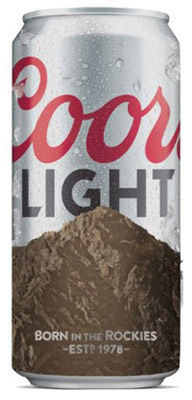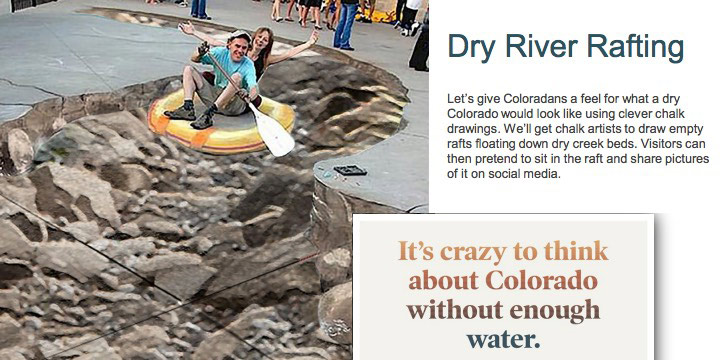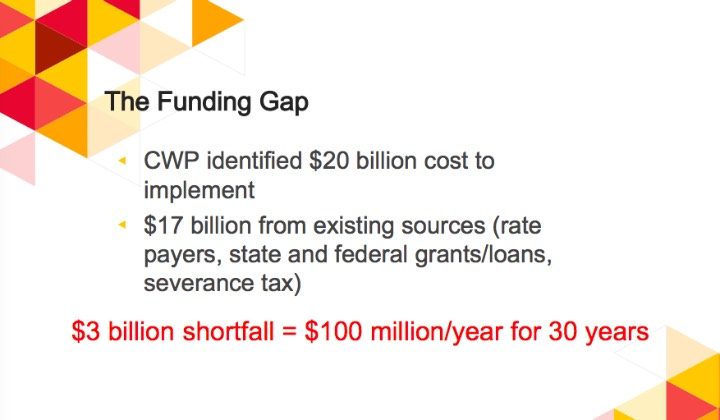“No one will ever consider wasting water once this [ad] campaign is done…”
— Denver Metro Chamber president Kelly Brough, as quoted in the online Colorado Sun.
If you were directing a coalition called ‘For the Love of Colorado’ and you wanted to get people to voluntarily increase their own taxes to fund a $40 billion ‘water plan’… you might hire a marketing company like Sukle, which bills themselves online as “Sukle: Denver’s Top Advertising & Design Agency.”
You might then ask this marketing company to spread fear and alarm all across the state with a multi-media advertising campaign that warns taxpayers that Colorado is running out of water.
We understand that there’s nothing like fear to motivate people. And the fear of living in a waterless desert probably ranks pretty high on the scariness scale, no matter if you’re a farmer, a fishing guide, or a school teacher.
One scary idea might include large billboards showing all of the snow gone from the Mountain that appears on the Coors Light beer cans.
Your selected ad agency might also cleverly suggest that, someday soon, a glass of beer will cost $28… unless the voters step up and fully fund the Colorado Water Plan.
‘For the Love of Colorado’ is calling it an “awareness campaign,” but what the organization really wants is to convince state residents to pay more for water management and infrastructure all across the state.
A lot more.
Another clever way to spread fear into the hearts of voters might be to create “Dry River Rafting” art installations, on sidewalks in Denver and other populated Colorado cities.
The marketing company might suggest:
“Let’s give Coloradans a feel for what a dry Colorado would look like using clever chalk drawings. We’ll get chalk artists to draw empty rafts floating down dry creek beds. Visitors can then pretend to sit in the raft and share pictures of it on social media.”
The above ideas, aimed at frightening Coloradans into voting for big tax increases, were posted on the Colorado Contractors Association website recently, as part of a 28-page Powerpoint document, Funding Colorado’s Water Plan.
According to their website, the ‘For the Love of Colorado’ coalition is sponsored by 21 “Partners”… a mix of ten environmental groups, a couple of industry organizations, two water districts and a handful of miscellaneous agencies.
The Steering Committee represents a similar mix… except that the environmental groups are basically missing.
The website does not mention the Walton Family Foundation as a sponsoring “partner.” Nor does it mention Denver Water. But somehow, those two organizations made it onto the Steering Committee.
The Colorado Water Plan, developed during the Hickenlooper administration and approved in 2015, has been described as “a new path to secure a water future that protects our state’s rivers; secures clean, safe, reliable drinking water for our communities; and preserves our agricultural heritage.” In 2013, the cost of CWP implementation was estimated by plan advocates at $20 billion.
Four years later, in 2017, Becky Mitchell, the newly appointed director of the state-funded Colorado Water Conservation Board, updated the estimate. Mitchell put the anticipated price tag at $40 billion, and “maybe more.” Some $18 billion was likely to be paid by existing sources such as municipalities, water utilities, and ditch companies that deliver water to farms and ranches, she said. She described the remaining $22 billion as an “unmet funding need.”
“Cost projections have always been just estimates, and part of that is because not all the information is in,” Mitchell said. “What we’re already seeing, as folks are solidifying our numbers, is that it’s going to be more than earlier predictions.”
Two years later, in May 2019, the well-funded ‘For the Love of Colorado Coalition’ published a report quoting the estimated price of CWP implementation as $20 billion.
Apparently, the Steering Committee prefers the $20 billion estimate from 2013, over the updated $40 billion estimate from 2017.
In the face of such uncertainty — not only about the cost of water projects, but also about the “diminishing supply of water” claimed in ‘For the Love of Colorado’ marketing materials — our local San Juan Water Conservancy District (SJWCD) is committed to understanding various alternative approaches to ensuring adequate water supplies in Archuleta County, as the Board constructs a ‘strategic plan’ to guide the district’s decisions over the next few years.
2019 has thus far been a banner year, in terms of abundant water supplies in Colorado, unlike some of the more ‘drought-prone’ years we’ve experienced since 2001. This past May, the US Department of Agriculture declared Colorado to be “99.99%” drought-free, an amazing turnaround from a year ago when 80% of the state was experiencing some level of dryness. In fact, it was the lowest amount of dryness in Colorado since the USDA Drought Monitor began tracking drought in 2000.
In May, only 0.01% of the state — about 8 square miles — was experiencing abnormally dry conditions… in Montezuma and Yuma counties… but those areas were not considered to be in a “drought” condition.
And Colorado’s snowpack was at 240% of normal, according to the Natural Resources Conservation Service.
Although the ‘For the Love of Colorado’ coalition might want us to believe ‘Math is really scary,’ the mathematics of water in 2019 is the very opposite of frightening. That $28 glass of beer seems especially hard to imagine, at this particular moment in time.
The topic I’d like to research for this editorial series has to do with ‘alternative approaches to a secure water supply’ — a chapter that will likely appear, someday soon, in the San Juan Water Conservancy District’s “Strategic Plan.” (Disclosure: I serve on the SJWCD Board and have been contributing to the draft “Strategic Plan.”)
If, indeed, Colorado’s population is going to double by 2050, and if indeed our water supply is not going to double, are there sensible (read: affordable) ways to address this dichotomy? Are there sensible (read: affordable) ways that have been tried successfully… in other parts of the world, for example?
Or is Colorado really going to be stuck with a $40 billion water infrastructure price tag?



